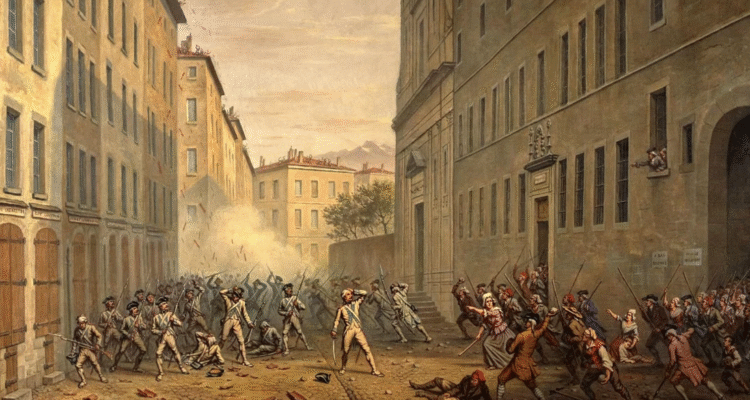Because every stone in Paris has witnessed defiance—and rebirth.
Paris has never merely survived upheaval—it has reimagined itself through it. Wars, revolutions, occupations, riots—conflict has scarred this city, yes, but it has also sculpted it, carving out boulevards, ideas, freedoms, and entire artistic movements in the process. Paris doesn’t hide its turbulent past—it incorporates it into its identity, brick by brick, word by word.
From guillotines to graffiti, from Haussmann’s “beautification by demolition” to the poetic resistance of May ’68, The Socialites trace how rebellion, ruin, and resilience shaped the Paris we walk today.
🔥 The French Revolution (1789–1799): Where it All Detonated
Conflict as birth canal for modern Paris.
This was the rupture that turned Versailles opulence into République ideals. The Bastille fell, heads rolled in the Place de la Révolution (now Concorde), and the concept of the citizen emerged. Churches were desecrated, art was looted, royal mansions became museums (hello, Louvre), and Paris’s center shifted from king to people.
🖋 Legacy: Republican values etched into daily life—from Liberté, Égalité, Fraternité on every mairie to the street names honouring Robespierre, Danton, and the sans-culottes.
🧱 The Commune of 1871: The City’s Brief Socialist Dream
When Paris briefly governed itself—and paid dearly.
After France’s defeat in the Franco-Prussian War, Paris declared itself autonomous, governed by artists, workers, and radicals. They abolished the draft, separated church and state, and even planned a feminist reform agenda. It ended in the “Bloody Week,” with thousands executed in Père Lachaise and the Buttes-Chaumont.
🖋 Legacy: Murals, place names, and the defiant energy of Belleville and Ménilmontant, where many Communards lived and died. Also? Paris’s obsession with public services.
🧨 Haussmannization: Urban Conflict by Design
The war between the past and progress.
Napoleon III’s appointment of Baron Haussmann in the mid-1800s wasn’t just about hygiene or beauty—it was political architecture. Medieval Paris was ripped apart to build wide boulevards that could not be barricaded. It was control disguised as elegance.
🖋 Legacy: The city’s signature symmetry—and its hidden trauma. Haussmann’s vision still stirs controversy over gentrification, displacement, and state power dressed in stone.
🕵️ WWII and the Nazi Occupation (1940–1944): Silence, Secrets, Sabotage
The dark heart of modern memory.
Paris fell quickly in 1940. The Louvre was emptied, the métro went eerily silent, and the Resistance moved underground—literally. Secret presses, sabotage, and coded messages flourished while Jews were rounded up from familiar streets (notably at the Vél d’Hiv).
🖋 Legacy:
-
Shoah Memorial in the Marais
-
Street plaques for deported schoolchildren
-
The mythologized Résistance, immortalised in film, literature, and quiet heroism
🪧 May 1968: Protest, Poetry, and Pavés
When students and workers nearly toppled the Republic with ideas—and cobblestones.
In a blaze of anti-capitalist, anti-authoritarian fervour, Paris students and striking workers shut down the country. They occupied the Sorbonne, clashed with police, and covered the Latin Quarter in posters, slogans, and dreams of another kind of France.
🖋 Legacy:
-
“Sous les pavés, la plage.” (Beneath the cobblestones, the beach.)
-
A lasting aesthetic of resistance—think hand-drawn protest posters and politicised design
-
The eternal Left Bank as bastion of critique and counterculture
🧑🎨 Artistic Response to Conflict: From Revolution to Raves
Paris never just absorbs conflict—it responds with art.
-
Eugène Delacroix’s Liberty Leading the People is pure 1830 rebellion in oil.
-
The Situationists in the 60s made art out of urban détournement—rewriting the city as a game.
-
Today’s street art in the 13e and Belleville riffs on migration, police violence, and memory with colour and code.
🖋 Legacy: A city where resistance isn’t just political—it’s creative language.
🏛 The Architecture of Aftermath
Conflict shaped how Paris is built, rebuilt, and remembered.
-
The Panthéon was a church—until the Revolution made it secular, and conflict turned it into a crypt for thinkers.
-
The Centre Pompidou, post-’68, was a radical act: inside-out, open-access, designed to democratise culture.
-
Place de la République, once a military monument, is now a site of vigils, marches, and skateboards.
Final Word from The Socialites
Conflict didn’t just rattle Paris. It redefined it—again and again.
Revolution isn’t just history here—it’s a design principle, a language, a lifestyle.
And every shadow cast by this city’s beauty holds a rebellion just beneath it.
Because Paris doesn’t heal quietly. It reinvents—loudly, lavishly, and always on its own terms.
—The Socialites


